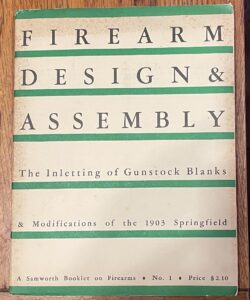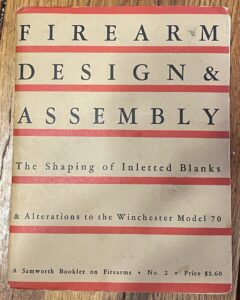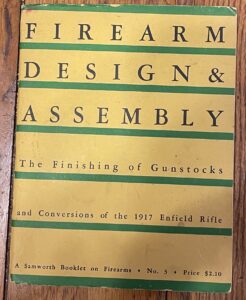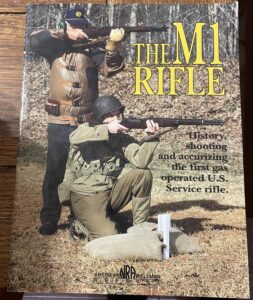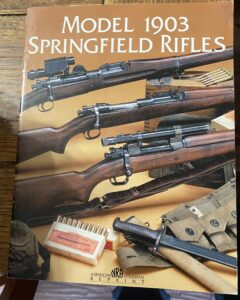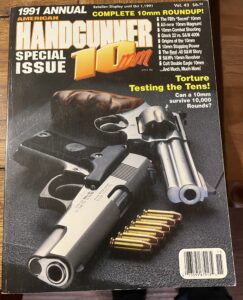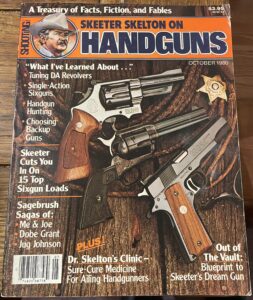How do you feel about gunstocks?
Not gun stocks, but gunstocks. The kind made out of wood, back in the day before synthetics became common.
After the jump, some more Samworths for those of you who still like wood.
Firearm Design & Assembly: The Inletting of Gunstock Blanks & Modifications of the 1903 Springfield, Alvin Linden. Small-Arms Technical Publishing Company, Plantersville, South Carolina, 1941. Riling 2367.
Firearm Design & Assembly: The Shaping of Inleted Blanks & Alterations to the Winchester Model 70, Alvin Linden. Small-Arms Technical Publishing Company, Georgetown, South Carolina, 1941. Riling 2443. (Riling lists this with a 1943 copyright date, but Smith lists it as 1941. I can’t find a copyright date inside. Since this is the second in the series, the 1941 seems more probable to me.)
Firearm Design & Assembly: The Finishing of Gunstocks and Conversions of the 1917 Enfield Rifle, Alvin Linden. Small-Arms Technical Publishing Company, Georgetown, South Carolina, 1941. Riling 2366.
I can’t find a lot of information about Alvin Linden, other than he was a highly regarded custom rifle maker who specialized in stocks, and Thomas Samworth commissioned him to write a series of books for SATPCO. He completed these three before he passed away in 1946. Samworth had a bunch more planned, including Metal Parts and Operations, Repairs and Refinishing of Gunstocks, and a single-volume compilation of Linden’s gunstock books.
These are odd Samworths. They are softbound, and more like large-format paper pamphlets than the normal SATPCO hardcover. They are also extremely fragile, especially given that they are 82 years old by now. I’m afraid to even handle them more than I have to. Smith says there was a complete one-volume reprint by Stackpole, which is also allegedly hard to find and which I will have to look for.
Based on the ad page dates in Smith’s bibliography, The Shaping of Inleted Blanks and The Finishing of Gunstocks are both third printings (1949 and 1948 ad page dates, respectively), while The Inletting of Gunstock Blanks appears to be a true first. Each of the three booklets included “pattern sheets”, so the professional or home gunsmith could follow along: The Inletting of Gunstock Blanks and The Shaping of Inleted Blanks both include the (also highly fragile) pattern sheets, while The Finishing of Gunstocks does not. So I’ll have to look for another copy of that with the sheets as well. (The Stackpole reprint also includes the sheets.) There is also a fourth volume which I don’t have, Checkering and Carving of Gunstocks by Monty Kennedy, which was published as a hardcover with bound-in pattern sheets.
I paid $50 for each of these from a vendor in Tulsa. He doesn’t have a web presence as such, but operates out of Tulsa twice a year and in between sells books on eBay under “Conants Landing” or “Liberty Lives Books”. He also threw in two of those NRA reprint volumes I was interested in:
The M-1 Rifle and Model 1903 Springfield Rifles.
Also picked up in Tulsa:
American Handgunner Annual: 10mm Special Issue. A collection of articles on the 10mm (and to a lesser extent the .40 S&W). Includes multiple articles by Massad Ayoob, John Taffin, and Frank W. James. “The FBI’s ‘Secret’ 10mm” is the S&W 1076, in case you were wondering.
This was part of the Gardner’s Books haul. I said I probably wasn’t going to document all the ephemera, but I did want to mention this one for the “10 mil is BEST MIL” meme.
Sketer Skelton on Handguns. This is an old Shooting Times collection (the cover says “October 1980”) of Skeeter Skelton‘s articles and columns for the magazine. I swear I had a copy of this when I was a teenager, but it vanished somewhere.
I’ve written about Skeeter Skelton before. Briefly: he was a lawman and a rancher before he embarked on the far more lucrative profession of gun writer. He was pretty famous as a big-bore revolver guy, especially as a fan of the .44 Special. (Though there’s an interesting piece in this volume: Skeeter and his friends fire 5,000 rounds each through a Colt Gold Cup and Colt Commander to see how they hold up. Spoiler: they hold up pretty well.)
You can find some of Skeeter’s writings (including a profile of Bill Jordan) here.
This was purchased for $5 off an anonymous vendor’s table in Tulsa. I think that’s below market, but I can’t find a copy for sale online. And the vendor seemed happy to be letting it go to someone who knew who in the fark Skeeter Skelton was.
